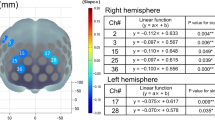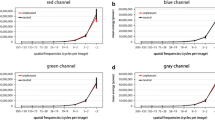Abstract.
To investigate when and how spatial attention affects somatosensory processing, event-related brain potentials (ERPs) were recorded in response to mechanical tactile stimuli delivered to the left and right hand while attention was directed to one of these hands. The attended hand either remained constant throughout an experimental block (sustained attention), or was changed across successive trials (transient attention). Attentional modulations of the N140 component and a sustained 'processing negativity' for attended stimuli were observed in both attention conditions. However, attentional effects on earlier somatosensory components differed systematically. Sustained attention resulted in a contralateral negativity overlapping with the N80 component, while transient attention was reflected by a bilateral positivity overlapping with the P100 component. This dissociation indicates that sustained and transient attention affect different somatosensory areas. It is suggested that sustained attention can modulate tactile processing within primary somatosensory cortex (S1), while effects of transient attention are located beyond S1. Overall, results demonstrate that spatial selectivity in touch is mediated by activity modulations in modality-specific somatosensory cortex.



Similar content being viewed by others
Notes
In these studies, attentional modulations of the somatosensory N140 component were also found when attention was directed to one side for a visual or auditory task, thus demonstrating crossmodal links in spatial attention (cf. Eimer 2001; Eimer and Driver 2001 for reviews).
However, note that recent intracranial SEP recordings (Barba et al. 2002; Frot and Maguière 1999) have suggested that some S2 sources may already be active between 60 ms and 90 ms poststimulus.
Note that this result is in line with informal observations from our previous study investigating crossmodal links in spatial attention (Eimer et al. 2001), where attentional modulations of the contralateral N80 component were present for sustained attention (Experiment 1; see also Hötting et al. 2003), but not for transient attention (Experiment 2).
One finding which may appear inconsistent with this hypothesis is that vocal RTs were faster with trial-by-trial cueing than with sustained attention. However, this difference is presumably due to a spatially unspecific alerting effect of precues. Visual stimuli presented at the start of each trial act as warning signals, and thus increase overall response readiness. This will speed up responses, especially if targets are infrequent, as in the present study.
Another issue that may be resolved in future high-density SEP studies is whether tactile-spatial attention modulates the amplitudes of early exogenous SEP components (N80, P100), or whether the effects of attention observed in the N80 and P100 time range are primarily due to an overlap of these components with an endogenous attentional negativity (or positivity). Figure 2 suggests that early attentional modulations only partially overlapped with the N80 and P100, which seems more in line with the overlap idea than with a pure amplitude modulation account.
References
Allison T, McCarthy G, Wood CC (1992) The relationship between human long-latency somatosensory evoked potentials recorded from the cortical surface and from the scalp. Electroencephalogr Clin Neurophysiol 84:301–314
Barba C, Frot M, Valeriani M, Tonali P, Maugière F (2002) Distinct fronto-central N60 and supra-sylvian N70 middle-latency components of the median nerve SEPs as assessed by scalp topographic analysis, dipolar source modelling and depth recordings. Electroencephalogr Clin Neurophysiol 113:981–992
Desmedt JE, Robertson D (1977) Differential enhancements of early and late components of the cerebral somatosensory evoked potentials during forced-pace cognitive tasks in man. J Physiol 271:761–782
Eimer M (1996) ERP modulations indicate the selective processing of visual stimuli as a result of transient and sustained spatial attention. Psychophysiology 33:13–21
Eimer M (2001) Crossmodal links in spatial attention between vision, audition, and touch: evidence from event-related brain potentials. Neuropsychologia 39:1292–1303
Eimer M, Driver J (2000) An event-related brain potential study of cross-modal links in spatial attention between vision and touch. Psychophysiology 37:697–705
Eimer M, Driver J (2001) Crossmodal links in endogenous and exogenous spatial attention: evidence from event-related brain potential studies. Neurosci Biobehav Rev 25:497–511
Eimer M, Cockburn D, Smedley B, Driver J (2001) Cross-modal links in endogenous spatial attention are mediated by common external locations: evidence from event-related brain potentials. Exp Brain Res 139:398–411
Eimer M, Van Velzen J, Driver J (2002) Crossmodal interactions between audition, touch and vision in endogenous spatial attention: ERP evidence on preparatory states and sensory modulations. J Cogn Neurosci 14:254–271
Frot M, Mauguière F (1999) Timing and spatial distribution of somatosensory responses recorded in the upper bank of the sylvian fissure (SII area) in humans. Cereb Cortex 9:854–863
Frot M, Rambaud L, Guénot M, Maugière F (1999) Intracortical recordings of early pain-related CO2-laser evoked potentials in human second somatosensory (SII) area. Clin Neurophysiol 110:133–145
García-Larrea L, Lukaszewicz AC, Mauguière F (1995) Somatosensory responses during selective spatial attention: The N120-to-N140 transition. Psychophysiology 32:526–537
Hari R, Reinikainen K, Kaukoranta E, Hämäläinen M, Ilmoniemi R, Penttinen A, Salminen J, Teszner D (1984) Somatosensory evoked cerebral magnetic fields from SI and SII in man. Electroencephalogr Clin Neurophysiol 57:254–263
Hötting K, Röder B, Rösler F (2003) Crossmodal and intermodal attention modulates event–related brain potentials to tactile and auditory stimuli. Exp Brain Res (in press)
Hsiao SS, O'Shaughnessy DM, Johnson KO (1993) Effects of selective attention on spatial form processing in monkey primary and secondary somatosensory cortex. J Neurophysiol 70:444–447
Hyvärinen J, Poranen A, Jokinen Y (1980) Influence of attentive behavior on neuronal responses to vibration in primary somatosensory cortex of the monkey. J Neurophysiol 43:870–882
Iwamura Y, Iriki A, Tanaka M (1994) Bilateral hand representation in the postcentral somatosensory cortex. Nature 369:554–556
Johansen-Berg H, Christensen V, Woolrich M, Matthews PM (2000) Attention to touch modulates activity in both primary and secondary somatosensory areas. Neuroreport 11:1237–1241
Josiassen RC, Shagrass C, Roemer RA, Ercegovac DE, Straumanis JJ (1982) Somatosensory evoked potential changes with a selective attention task. Psychophysiology 19:146–159
Mangun GR, Hillyard SA (1991) Modulations of sensory-evoked brain potentials indicate changes in perceptual processing during visual-spatial priming. J Exp Psychol Hum Percept Perform 17:1057–1074
Mauguière F, Merlet I, Forss N, Vanni S, Jousmaki V, Adeleine P, Hari R (1997) Activation of a distributed somatosensory cortical network in the human brain: a dipole modelling study of magnetic fields evoked by median nerve stimulation. Part II: effects of stimulus rate, attention and stimulus detection. Electroencephalogr Clin Neurophysiol 104:290–295
Meyer E, Ferguson SS, Zatorre RJ, Alivisatos B, Marret S, Evans AC, Hakim AM (1991) Attention modulates somatosensory cerebral blood flow response to vibrotactile stimulation as measured by positron tomography. Ann Neurol 29:440–443
Michie PT (1984) Selective attention effects on somatosensory event-related potentials. Ann N Y Acad Sci 425:250–255
Michie PT, Bearpark HM, Crawford JM, Glue LCT (1987) The effects of spatial selective attention on the somatosensory event-related potential. Psychophysiology 24:449–463
Mima T, Nagamine T, Nakamura K, Shibasaki H (1998) Attention modulates both primary and second somatosensory cortical activities in humans: a magnetoencephalographic study. J Neurophysiol 80:2215–2221
Pons TP, Garraghty PE, Mishkin M (1992) Serial and parallel processing of tactual information in somatosensory cortex of rhesus monkeys. J Neurophysiol 68:518–527
Posner MI (1978) Chronometric explorations of mind. Erlbaum, Hillsdale, NJ
Posner MI, Nissen MJ, Ogden WC (1978) Attended and unattended processing modes: the role of set for spatial location. In: Pick HL, Saltzman EJ (eds) Modes of perceiving and processing information. Erlbaum, Hillsdale, NJ, pp 137–157
Powell TPS (1977) On somatic sensory cortex. Br Med Bull 33:129–136
Sathian K, Burton H (1991) The role of spatially selective attention in the tactile perception of texture. Percept Psychophys 50:237–248
Spence C, Driver J (1994) Covert spatial orienting in audition: exogenous and endogenous mechanisms facilitate sound localization. J Exp Psychol Hum Percept Perform 20:555–574
Spence C, Pavani F, Driver J (2000) Crossmodal links between vision and touch in covert endogenous spatial attention. J Exp Psychol Hum Percept Perform 26:1298–1319
Van Velzen J, Forster B, Eimer M (2002) Temporal dynamics of lateralized ERP components elicited during endogenous attentional shifts to relevant tactile events. Psychophysiology 39:874–878
Woldorff MG, Gallen CC, Hampson SR, Hillyard SA, Pantev C, Sobel D, Bloom FE (1992) Modulation of early sensory processing in human auditory cortex during auditory selective attention. Proc Natl Acad Sci U S A 90:8722–8726
Acknowledgements.
This research was supported by a grant from the Biotechnology and Biological Sciences Research Council (BBSRC). The authors thank Carolyn Rice for technical assistance, and two anonymous reviewers for helpful comments.
Author information
Authors and Affiliations
Corresponding author
Rights and permissions
About this article
Cite this article
Eimer, M., Forster, B. Modulations of early somatosensory ERP components by transient and sustained spatial attention. Exp Brain Res 151, 24–31 (2003). https://doi.org/10.1007/s00221-003-1437-1
Received:
Accepted:
Published:
Issue Date:
DOI: https://doi.org/10.1007/s00221-003-1437-1




